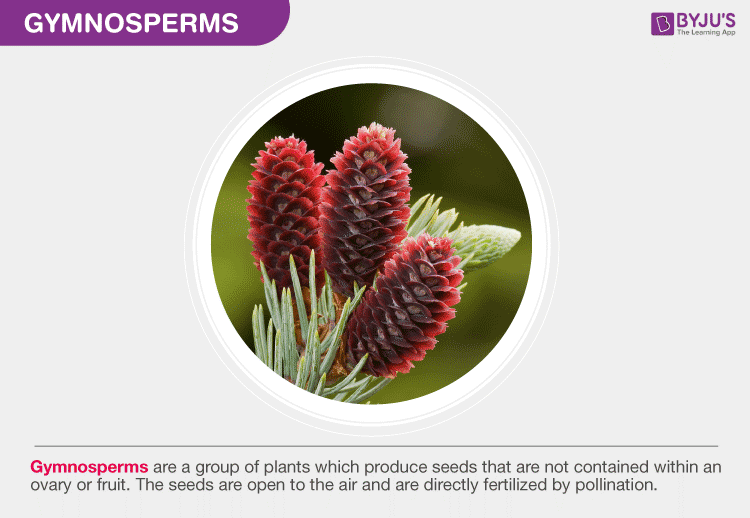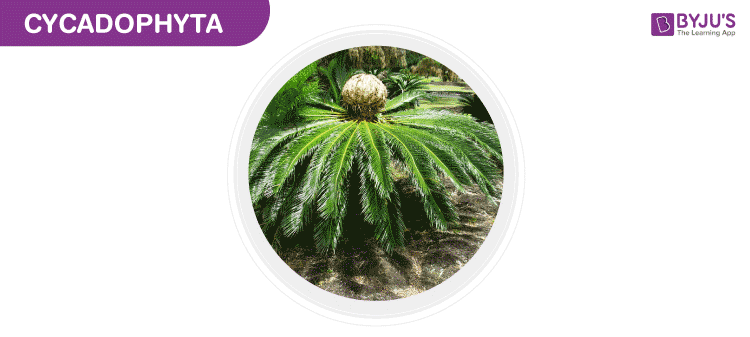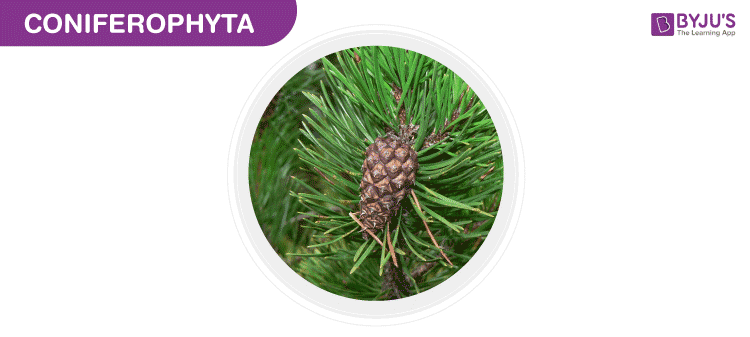
Gymnosperms Definition
“Gymnosperms are a group of plants that produce seeds not enclosed within the ovary or fruit.”
Table of Contents
What are Gymnosperms?
The word “Gymnosperm” comes from the Greek words “gymnos”(naked) and “sperma”(seed), hence known as “Naked seeds.” Gymnosperms are the seed-producing plants, but unlike angiosperms, they produce seeds without fruits. These plants develop on the surface of scales or leaves, or at the end of stalks forming a cone-like structure.
Gymnosperms belong to kingdom ‘Plantae‘ and sub-kingdom ‘Embryophyta’. The fossil evidence suggested that they originated during the Paleozoic era, about 390 million years ago.
Basically, gymnosperms are plants in which the ovules are not enclosed within the ovary wall, unlike the angiosperms. It remains exposed before and after fertilisation and before developing into a seed. The stem of gymnosperms can be branched or unbranched. The thick cuticle, needle-like leaves, and sunken stomata reduce the rate of water loss in these plants.
The family of gymnosperms consist of conifers, the cycads, the gnetophytes and the species of Gynkgophyta division and Ginkgo biloba.
Let us have an overview of the characteristics, examples, classification and examples of gymnosperms.

Gymnosperms
Characteristics of Gymnosperms
Following are the important characteristics of gymnosperms:
- They do not produce flowers.
- Seeds are not formed inside a fruit. They are naked.
- They are found in colder regions where snowfall occurs.
- They develop needle-like leaves.
- They are perennial or woody, forming trees or bushes.
- They are not differentiated into ovary, style and stigma.
- Since stigma is absent, they are pollinated directly by the wind.
- The male gametophytes produce two gametes, but only one of them is functional.
- They form cones with reproductive structures.
- The seeds contain endosperm that stores food for the growth and development of the plant.
- These plants have vascular tissues which help in the transportation of nutrients and water.
- Xylem does not have vessels and the phloem has no companion cells and sieve tubes.
Also Read: Angiosperms
Classification of Gymnosperms
Gymnosperms are classified into four types as given below –
Cycadophyta
Cycads are dioecious (meaning: individual plants are either all male or female). Cycads are seed-bearing plants where the majority of the members are now extinct. They had flourished during the Jurassic and late Triassic era. Nowadays, the plants are considered as relics from the past.
These plants usually have large compound leaves, thick trunks and small leaflets which are attached to a single central stem. They range in height anywhere between a few centimetres to several meters.
Cycads are usually found in the tropics and subtropics. Some members have adapted to dry arid conditions and some also have adapted to oxygen-poor swampy environments.

Ginkgophyta
Another class of Gymnosperms, Ginkgophyta, has only one living species. All other members of this class are now extinct.
The Ginkgo trees are characterised by their large size and their fan-like leaves. Also, Ginkgo trees have a large number of applications ranging from medicine to cooking. Ginkgo leaves are ingested as a remedy for memory-related disorders like Alzheimer’s.
Ginkgo trees are also very resistant to pollution, and they are resilient against diseases and insect infestations. In fact, they are so resilient that after the nuclear bombs fell on Hiroshima, six Ginkgo trees were the only living things to survive within a kilometre or two of the blast radius.

Gnetophyta
Just like any other member of gymnosperms, Gnetophytes are also relics from the past. Today, only three members of this genus exist.
Gnetophytes usually consist of tropical plants, trees, and shrubs. They are characterised by flowery leaves that have a soft coating. This coating reveals an ancestral connection with the angiosperms.
Gnetophytes differ from other members of this class as they possess vessel elements in their xylem.

Coniferophyta
These are the most commonly known species among the gymnosperm family. They are evergreen; hence they do not shed their leaves in the winter. These are mainly characterised by male and female cones which form needle-like structures.
Coniferous trees are usually found in temperate zones where the average temperature is 10 ℃. Giant sequoia, pines, cedar and redwood are examples of Conifers.

Gymnosperms Examples
Following are some of the examples of gymnosperms:
- Cycas
- Pinus
- Araucaria
- Thuja
- Cedrus
- Picea
- Abies
- Juniperus
- Larix
Gymnosperms Life Cycle
The life cycle of gymnosperms is both haploid and diploid, i.e., they reproduce through the alternation of generations. They have a sporophyte-dominant cycle.
The gametophyte phase is relatively short. The reproductive organs are usually cones.
Male Cones– These have microsporophylls that contain microsporangia. Microsporangium produces haploid microspores. A few microspores develop into male gametes called pollen grains, and the rest degenerate.
Female Cones– The megasporophylls cluster together to form female cones. They possess ovules containing megasporangium. It produces haploid megaspores and a megaspore mother cell.
The pollen reaches the egg through wind or any other pollinating agent, and the pollen grain releases a sperm. The nuclei of male and female gametophytes fuse together to form a zygote. This is known as fertilisation.
The seed appears as scales which can be seen on the cones of the gymnosperm.
Recommended Video:

Key Points on Gymnosperms
- Gymnosperms are non-flowering plants belonging to the sub-kingdom Embophyta.
- The seeds are not enclosed in an ovary or fruit. They are exposed on the surface of the leaf-like structures of the gymnosperms.
- They can be classified as Coniferophyta, Cycadophyta, Ginkgophyta and Gnetophyta.
- Gymnosperms are found in boreal and temperate forests.
Also Read: Alternation of Generations
To know more about what are Gymnosperms, its characteristics, classification, examples and life cycle of gymnosperms, keep visiting BYJU’S website. Download the BYJU’S app for further reference.
Frequently Asked Questions
What is gymnosperm?
Gymnosperm is a seed-producing plant that includes conifers, cycads, gnetophytes and ginkgos. They do not produce flowers or fruits and have naked seeds.
Do gymnosperms have an embryo?
Yes, gymnosperms do have an embryo. In gymnosperms, the ovule becomes the seed encasing the embryo and endosperm in a seed coat, but it does not develop into a fruit after fertilisation.
Give a few examples of gymnosperms.
Cycas, pinus, Thuja, Cedrus, Abies, Larix are some of the examples of gymnosperms.
How are gymnosperms different from an angiosperm?
Angiosperms are called flowering plants, whereas gymnosperms are called non-flowering plants. Angiosperms have seeds enclosed in an ovary (a fruit) whereas gymnosperms have no flowers or fruits and have naked seeds on the surface of leaves.
How are the gymnosperms classified?
The gymnosperms are classified as- Cycadophyta, Ginkophyta, Gnetophyta, Coniferophyta.
Which stage dominates the life cycle of gymnosperms?
The haploid stage is the dominant stage in the life cycle of the gymnosperms. In this stage, a multicellular haploid gametophyte develops from the spore and produces haploid gametes. The gametophyte when matures produces male and female gametes which join to form a diploid zygote.
Where are gymnosperms found?
Gymnosperms are usually found in colder regions when snowfall occurs. However, cycads are found in dry and tropical regions.

i like the stuff on gymnosperm and its classification. its easy to understand.
Ovary present in gymnosperm or not
Gymnosperms have no ovaries, hence they cannot produce fruits.
Thanks byjus for such a simple explanation.
Which stage is dominant in gymnosperms?
SO GOOD BYJU’S HELP ME TOO MUCH